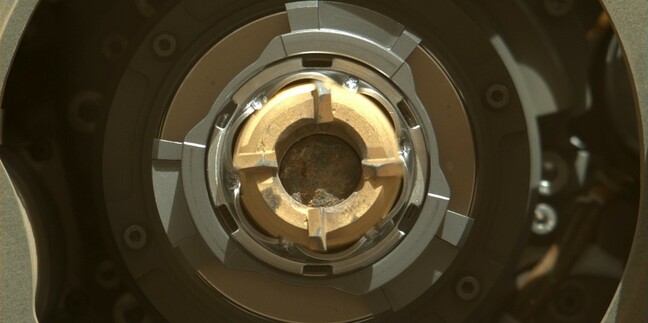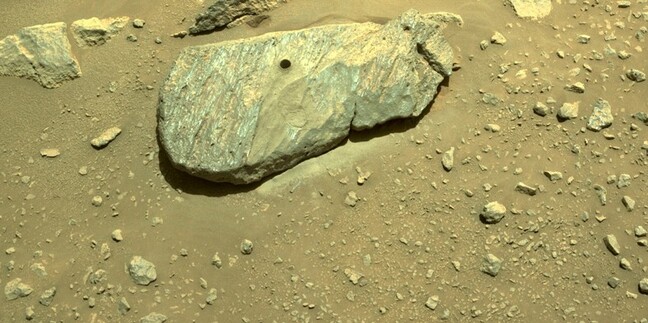This article is more than 1 year old
Perseverance rover drilled a rock on Mars and probably snaffled a core sample
Now to enact humanity's cunning interplanetary kidnapping plan
NASA's Perseverance Mars rover has successfully drilled into a rock and probably retrieved a sample it's hoped will one day be kidnapped on a one-way trip to Earth.
Perseverance's first attempt to obtain a core sample of a Martian rock failed when its chosen target crumbled beneath the might of Earth's finest drilling equipment.
NASA therefore scratched Perseverance's second target before drilling, in the hope that would prove it a suitable target.
On Friday, NASA reported success.
"Data received late Sept. 1 from NASA's Perseverance rover indicate the team has achieved its goal of successfully coring a Mars rock," the Agency stated. "The initial images downlinked after the historic event show an intact sample present in the tube after coring.”
Here is NASA's image of that sample.

Perseverance rover core sample tube with rock inside. Click to enlarge.
Image: NASA/JPL-Caltech/ASU/MSSS
And here's the hapless rock that Perseverance cored, for all mankind.
Don't pop the champagne just yet, dear reader. Because after NASA took the shot of the rock in the tube, Perseverance then "began a procedure called 'percuss to ingest,' which vibrates the drill bit and tube for one second, five separate times.
"The movement is designed to clear the lip of the sample tube of any residual material … and can also cause a sample to slide down farther into the tube."
- Everyone's going to Mars: Rocket Lab joins the Red Planet Fan Club
- China's Mars rover assigned extended mission after exceeding life expectancy
- Here boy! Making the Sample Fetch Rover that'll collect soil from the Red Planet
After the ingest-percussion, NASA tried to get some more snaps of the sample to check all had gone as planned.
"In these images, the lighting is poor, and internal portions of the sample tube are not visible," NASA warned. More snaps will be taken in due course so that NASA can feel sure the process worked.
For now, NASA's position is that it's "encouraged that there is sample in this tube".
Perseverance carries 43 sample tubes, each of which can hold a sliver of rock about the size of a pencil. Mission plans call for the capture of around 20 samples and their eventual return to Earth in a mission that's been sketched out to launch in 2026 and return the samples to Earth in 2031.
While humanity has returned samples from asteroids, comets, the Moon, and snaffled some grains blowing around in the Solar Wind, Martian gravity is stronger than that faced by any previous sample return mission. That's what makes the retrieval of the sample Perseverance (hopefully) picked up very challenging indeed. ®

